 Economy
Economy


|
| A Grab driver receives a takeaway order from a restaurant's order in Hà Nội in early June when in-person dining is not allowed amid surging COVID-19 cases. — VNA/VNS Photo |
HÀ NỘI — The latest updates from the General Statistics Office (GSO) showed that the Vietnamese economy expanded by 5.64 per cent in the first half of this year, much higher than the growth rate of 1.82 per cent recorded in the same period of last year.
Although the economic growth rate in the first half of this year was lower than the rate of 7.05 per cent and 6.77 per cent of the same periods of 2018 and 2019, respectively, before the COVID-19 pandemic, the macro-economy remained stable with recoveries in production and business, GSO’s Director Nguyễn Thị Hương said at a press conference on Tuesday in Hà Nội.
Hương said the economic achievements in the first half of this year were impressive as the outbreak of the virus in late April posed a lot of challenges to the Government’s goal of preventing the virus and at the same time promoting economic development.
The agro-forestry-fishery sector rose by 3.82 per cent, contributing 8.17 per cent, industry and construction rose by 8.36 per cent, contributing 59.05 per cent and the services sector was up by 3.96 per cent, contributing 32.78 per cent to the overall growth, statistics showed.
The industrial production increased by nine per cent in January – June, nearly equivalent to the rate of 9.13 per cent recorded in the pre-pandemic 2019’s first half and higher than the rate of 2.91 per cent of the same period last year.
GSO said that the manufacturing and processing industry remained the driver for economic growth with an expansion of 11.42 per cent in the period.
The accommodation and catering services, passenger transportation and tourism remained in difficulty due to the social distancing in some localities to prevent the virus and the impacts of the pandemic.
Statistics showed that tourism revenue dropped by 51.8 per cent in the period to VNĐ4.5 trillion with the number of foreign tourist arrivals tumbling by 91.6 per cent to 88,200 in the first half of this year.
In the second quarter alone, the economy expanded at 6.61 per cent, compared to a modest rate of 0.39 per cent of the same period last year but still lower than the rate of 6.73 per cent recorded in the same quarters of 2018 and 2019.
The economy expanded quickly in the second quarter on robust exports and industrial production and the implementation of the vaccination campaign although the country was facing the most serious COVID-19 outbreak so far.
Việt Nam earned revenue of $317.73 billion in import and export in the January – April period, up by 32.2 per cent.
The country ran a trade deficit of $1.47 billion in the period.
GSO’s statistics also revealed recoveries in production and business. Demand deposits tended to increase after the State Bank of Việt Nam slashed rates in 2020. Credit growth reached 5.47 per cent as of June 21, compared to 2.45 per cent in the same period last year.
The securities market saw strong growth from the beginning of this year, which helped raise VNĐ116.4 trillion for the economy as of the end of May, up by 68 per cent.
Hương said that the good economic achievements in the first half of this year demonstrated the Government’s determination and drastic efforts to prevent the spread of the virus as well as to promote socio-economic development.
Still, the virus was developing in some provinces and cities, which were posing a number of challenges to the management and administration to develop the economy and ensure social security, she said.
The consumer price index rose 0.19 per cent in June against the previous month on increases in prices of some input materials, water and electricity.
On average, CPI rose by 1.47 per cent in the first half of this year over a year earlier, the lowest increase since 2016. — VNS




